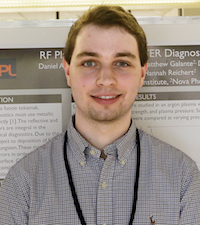
Daniel Alexander
Rensselaer Polytechnic Institute
RF Plasma Cleaning of ITER Diagnostic Mirrors
Daniel Alexander, Fred Levinton, Matthew Galante, Darrell DiCicco, David Cylinder, Hannah Reichert
Metallic first mirrors (FMs) in ITER are an integral part of the operation of optical diagnostics. The sputtering of first wall materials onto FMs can negatively impact optical properties of the mirrors on which the functions of the diagnostics depend, and thus a robust in-situ cleaning method must be implemented. At PPPL, Nova Photonics is developing a novel RF plasma cleaning system that will be deployed on ITER diagnostics. Understanding the effect of altering operating parameters on the mirror self-bias is crucial to optimizing the cleaning process. Self-bias is optimized based on observations, and a 50 nm layer of aluminum is coated on a stainless steel coupon and exposed to an RF neon plasma for cleaning. Results show an alteration in optical properties of the aluminum deposit, but both spectral and surface analysis are inconclusive regarding the success of the cleaning process. Further surface analysis techniques will achieve more accurate depth profiling and material composition of the sample.
Poster
Nathaniel Barbour
Yale University
Machine Learning Prediction of High-Current Disruptions with Low-Current Training Data
Nathaniel Barbour, Kornee Kleijwegt, Leonard Lupin-Jimenez, Egemen Kolemen
Disruption mitigation and avoidance are critical objectives for the successful operation of ITER. Of particu- lar interest is the prospect of predicting disruptions during its first high-plasma-current experiments, when only low-current data will be available. Toward achieving those objectives, data from an initial sample of 1,130 discharges are separated into two groups by plasma current. Four regression tree algorithms are then used as disruption predictors: AdaBoost, random forests, extremely randomized trees, and bootstrap aggregating (“bagging”). Each algorithm is trained using data from low-current discharges and used to predict disruptions in the sample of high-current discharges. To improve prediction accuracy, multiple methods of scaling the input signal data are examined. At a 93% correct disruption prediction rate, the AdaBoost algorithm only suffered a 3.2% false positive rate. As disruption prediction is a relatively new field, there exists a plethora of possible extensions. Several of these include the creation of a meta-estimator from the predictions of the four regression tree algorithms and the completion of a cross-device analysis using data from NSTX to predict disruptions at DIII-D.
Poster
Hunter Belanger
Rensselaer Polytechnic Institute
Laser Induced Incandescence of Carbon Nanotubes
Hunter Belanger, Shurik Yatom
Using the applicable heat transfer equation, a model was developed to describe the Laser Induced Incandescence (LII) signal of single walled carbon nanotubes which are formed using arc plasmas. The simulated signals from this model were then compared to the simulated signals of solid spherical carbon nanoparticles which also form in arc plasmas. It was found that the signal from the spherical particles decays far more slowly than the signal form the nanotubes, and that the nanotubes tend to have a much shorter signal rise time than that of the spherical particles. Mixtures of both spherical particles and carbon nanotubes were also analyzed, in an effort to identify methods for determining the composition of such mixtures from the LII signal.
Poster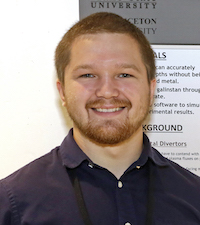
Gerrit Bruhaug
Idaho State University
Development of a Non-Contact, Inductive Depth Sensor for Free-Surface, Liquid-Metal Flows
Gerrit Bruhaug, Egemen Kolemen, Adam E. Fisher, Mike Hvasta
This paper details a non-contact based, inductive depth measurement system that can sit behind a layer of steel and measure the depth of the liquid metal flowing over the steel. Free-surface liquid metal depth measurement is usually done with invasive sensors that impact the flow of the liquid metal, or complex external sensors that require lasers and precise alignment. Neither of these methods is suitable for the extreme environment encountered in the diverter region of a nuclear fusion reactor, where liquid metal open channel flows are being investigated for future use. A sensor was developed that used the inductive coupling of a coil to liquid metal to measure the height of the liquid metal present. The sensor was built and tested experimentally, and modeled with finite element modeling software to further understand the physics involved. Future work will attempt to integrate the sensor into the Liquid Metal eXperiment (LMX) at the Princeton Plasma Physics Laboratory for more refined testing.
Poster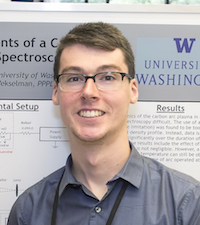
Daniel Cashon-Smith
University of Washington
Density Measurements of a Carbon Arc Using Stark Spectroscopy
Daniel Cashon-Smith, V. Vekselman
Arc discharges between carbon electrodes at near atmospheric pressures have been shown to be able to synthesize carbon nanostructures such as single-walled carbon nanotubes and fullerenes. These materials have unique material properties, such as high thermal and electrical conductivity, that make them of interest. This motivates an understanding of the carbon arc physics which play a role in nanosynthesis, of which at this point are not fully understood. This paper describes the setup of two diagnostics: fast-frame imaging (FFI) and optical emission spectroscopy (OES), and provides preliminary data to show how these diagnostics can add to the understanding of carbon arc physics.
Poster
Jared Carlson
Mesa Community College
Princeton Adaptable Stellarator for Education and Outreach (PASEO)
Jared Carlson, Arturo Dominguez
The PPPL Science Education Department, in collaboration with IPP, is currently developing a versatile small scale Stellarator for education and outreach purposes. The Princeton Adaptable Stellarator for Education and Outreach (PASEO) will provide visual demonstrations of Stellarator physics and serve as a lab platform for undergraduate and graduate students. Based off the Columbia Non-Neutral Torus (CNT), and mini-CNTs, PASEO will create pure electron plasmas to study magnetic surfaces. PASEO uses similar geometries to these, but has an adjustable coil configuration to increase its versatility and conform to a highly visible vacuum chamber geometry. To simulate the magnetic surfaces in these new configurations, a MATALB code utilizing the Biot Savart law and a Fourth Order RungeKutta method was developed, leading to new optimal current ratios. The design for PASEO and its predicted magnetic surfaces are presented.
Poster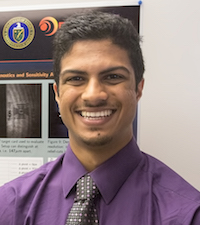
Nirbhav Chopra
University of Illinois, Urbana-Champaign
Schlieren Technique Applied to Magnetohydrodynamic Generator Plasma Torch
Nirbhav S. Chopra, Jacob Pearcy, Michael A. Jaworski
Magnetohy- drodynamic (MHD) generators are a promising augmentation to current hydrocarbon based combustion schemes for creating electrical power. In recent years, interest in MHD generators has been revitalized due to advances in a number of technologies such as superconducting magnets, solid-state power electronics and materials science as well as changing economics associated with carbon capture, utilization, and sequestra- tion. We use a multi-wavelength schlieren imaging system to evaluate electron density independently of gas density in a plasma torch under conditions relevant to MHD generators. The sensitivity and resolution of the optical system are evaluated alongside the development of an au- tomated analysis and calibration program in Python. Preliminary anal- ysis shows spatial resolutions less than 1mm and measures an electron density of ne = 1E16 cm^−3 in an atmospheric microwave torch.
Poster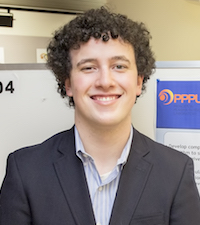
Chris Dolliff
Harvard University
Simulation of Collisions in Slab Geometry Approximation of Wave Driven Rotating Torus (WDRT)
Chris Dolliff, Nat Fisch, Ian Ochs
The Wave Driven Rotating Torus (WDRT) is an alternative field configuration to the traditional Tokamak field configuration for achieving magnetic confinement fusion. The idea is to replace the poloidal magnetic field in a tokamak with a radial electric field that causes a poloidal E cross B drift. The foundations of this system are laid out in detail by a paper by J. M. Rax, R. Gueroult, and Nat Fisch. Herein we outline the efforts to build a single particle pusher algorithm that could simulate the trajectory of a particle in any field, and specifically in the field of a simplified WDRT slab geometry. My code was built to analyze single particle trajectories and distribution evolution. The algorithm uses the Boris algorithm for numerical integration with a dynamic step size that adapts to the size of the magnetic field, written by myself. The algorithm also utilizes the Langevin model for collisions. We investigate the system in a regime where thermal velocity is larger but at the same order of magnitude of the drift velocity and where collisions are infrequent compared to system size. We see some qualitative correlation between some parameters and drift along Electric Field lines-corresponding to radial drift in a tokamak. We see evidence of temperature anisotropy, but need to investigate further to determine if long term anisotropy is maintained. Investigation into temperature anisotropy is particularly interesting as if the system is able to maintain some level of anisotropy over many system traversals much less energy would be lost to heat than predicted in fluid models where collisions are frequent and isotropy quickly reached.
Poster
Michael Greklek-McKeon
University of Maryland, College Park
Ballistic Dynamics of a Relativistic Electron Beam for Mapping of the Magnetosphere
Michael Greklek-McKeon, Andrew T. Powis, Peter Porazik, Igor D. Kaganovich
Electrons fired at relativistic speeds from a particle accelerator on an orbiting satellite will propagate along the field lines of Earth’s magnetosphere. If the particle beam is directed at an appropriate angle relative to the local magnetic field, it will travel until impacting the Earth’s atmosphere, and can stimulate emission that produces a characteristic signal or “artificial aurora” detectable by ground stations. Injecting electron beams from different points during different geomagnetic conditions would produce varying signals in the atmosphere that could be used to map the magnetosphere and examine questions on auroral arcs and energy transfers during solar storm events. Such a diagnostic tool would enable the direct validation of magnetospheric models, and contribute to the improvement of space weather prediction tools. To examine the viability of such an experiment, we determined the angular area relative to the local magnetic field over which particles would be deposited in the atmosphere for various injection points during the stages of a prominent geomagnetic event – the St. Patrick’s Day storm caused by the impact of a coronal mass ejection on March 17th 2015. After examining the loss cones for several injection points, we chose the most reliable one over all storm phases, and did full simulations of the beam dynamics as it traveled from the satellite to Earth. We determined the amount of spreading of the beam and the resulting spot size on the atmosphere, the energy deposited by the beam, and the relative locations of impact. The magnetic field information used in these simulations came from an aggregate of satellite data collected by NASA. This verification demonstrated that an electron beam emitted from a satellite can be fired into the loss cone of the Earth’s atmosphere and create an observable signal on the ground.
Poster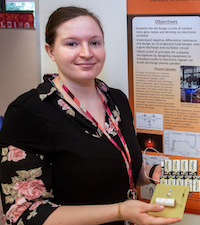
Barbara Israelson
Edinboro University
Neon Glow Lamps: Alternative Applications
Barbara Israelson, Johan Carlsson, Larry Guttadora
The applications of neon glow lamps, of various size and origins of manufacture, are examined and their properties explored. Data on the effect of current and voltage on the neon glow lamps, both NE-2 and IN-3, is taken when the lamps were in series with varying resistors. An electronic oscillator is built and its properties examined. A transformer and incandescent bulb is added in series to both an NE-2 lamp and a glow discharge tube. A plasma speaker is transformed into a plasma microphone with an antenna and a series of filters. The American and Russian lamps are characterized to determine their respective consistencies across manufacturing and to obtain data on their breakdown and subnormal regime curves.
Poster
Ayden Kish
Auburn University
Two-point modeling of SOL losses of HHFW power in NSTX
Ayden Kish, R.J. Perkins, J.W. Ahn, A. Diallo, T.K. Gray, J.C. Hosea, M.A. Jaworski, G.J. Kramer, B. LeBlanc, S.A. Sabbagh
The applications of neon glow lamps, of various size and origins of manufacture, are examined and their properties explored. Data on the effect of current and voltage on the neon glow lamps, both NE-2 and IN-3, is taken when the lamps were in series with varying resistors. An electronic oscillator is built and its properties examined. A transformer and incandescent bulb is added in series to both an NE-2 lamp and a glow discharge tube. A plasma speaker is transformed into a plasma microphone with an antenna and a series of filters. The American and Russian lamps are characterized to determine their respective consistencies across manufacturing and to obtain data on their breakdown and subnormal regime curves.
Poster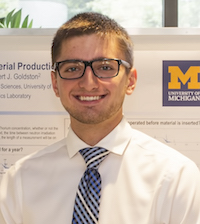
Evan Leppink
University of Michigan
Simulated Detection of Weapon Material Production in PbLi Blanket
Evan Leppink, Robert J. Goldston
A proliferation concern associated with magnetic fusion energy systems is the breeding of weapon-usable material using the high energy neutron flux from fusion reactions. It is then vital that such breeding is easily detectable and future fusion energy power systems may be verified to produce no weapon-usable material. This work investigates the detectability of the breeding of 233 U and 239 Pu in the lead-lithium blanket of a magnetic fusion reactor. Using MCNPX and an in-house transmutation simulation, it is found in all tested scenarios that the fissile material is easily detectable due to high energy gamma-rays emitted from fission products with the necessary measurement time on the order of seconds.
Poster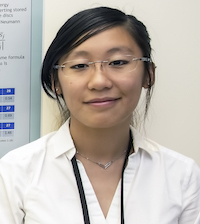
Jessica L. Li
Columbia University
Quench and Stress Coupled Analysis of High TC Superconducting Coils
Jessica L. Li, Yuhu Zhai
High-temperature superconductors (HTS) are promising candidates for compact next step fusion reactor designs due to their low power loss, higher margin and ability to carry extremely high current densities at high magnetic fields. However, unlike their low- temperature counterparts, HTS coils are much more vulnerable to damage during quench events under severe mechanical loading at high field magnet operation. It has been shown that the intensity of quench events may be mitigated by installing inductively coupled inserts around the superconducting coils. We use analytic models in FORTRAN and MATLAB to calculate the magnetic fields and resultant forces for various solenoid-like configurations of high-temperature superconducting coils. Inductance calculations are then done to aid simulations of the thermal, electric, and magnetic behaviors during quench-like events and to identify optimal designs for both stability and quench protection. We then extend these calculations to non-circular coils in order to analyze a HTS test design considered by the National Institute for Fusion Science (NIFS).
Poster
Dhruval Patel
University of Illinois, Urbana-Champaign
Investigating Methods Of Surface Wave Reconstuction
Dhruval Patel, Dhruvit Patel, Adam Fisher, Egemen Kolemen
A diagnostic tool to resolve the surface wave topology of a flowing liquid metal is under development. The setup uses a single camera to acquire an image being reflected off the liquid metal surface. Methods and algorithms were developed with the goal of decreasing the computation time and error. A 1D simulation of the problem is created to study the efficacy of each algorithm. This paper discusses the differences between he methods and compares the relative error and computation time required for each method. It was concluded that images with lower resolution can be used to get reliable results using any of these methods. Crude approximation using the linear method can yield results quickly with a reasonable margin of error.
Poster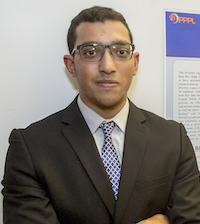
Dhruvit Patel
Rutgers University
Effects of Upstream Nozzle Geometry on Downstream Liquid Metal Flow
Dhruvit Patel, Dhruval Patel, Adam Fisher, Egemen Kolemen
The behavior of liquid metal is of interest in many areas of both research and industry such as tokamak Plasma Facing Components (PFC)-related research and metal casting, respectively. This experiment was performed on the Liquid Metal Experiment (LMX) open channel configuration to study the effects of upstream nozzle geometry on downstream flow behavior such turbulence-damping and hydraulic jumps in presence of an externally applied uniform magnetic field of varying strengths. It was determined that the honeycomb-nozzle that was designed and implemented in the channel served to reduce turbulence and create more favorable flow for tokamak conditions by pushing the hydraulic jump location further downstream than the no nozzle flow. A flow where the hydraulic jump occurs further downstream allows a faster supercritical flow to potentially improve heat transport due to convection. In the LMX, other issues like flow-wall separation were also studied and marginally mitigated.
Poster
Jacob A. Pearcy
Princeton University
Simulation of Atmospheric Plasma Arc Characteristics
Jacob A. Pearcy, Nirbhav S. Chopra, Michael A. Jaworski
We present the results of computer simulation of cylindrical plasma arcs with characteristics similar to those predicted to be relevant in magnetohydrodynamic (MHD) power conversion sys- tems. These arcs, with core temperatures on the order of 1 eV, place stringent limitations on the lifetime of conventional electrodes used in such systems, suggesting that a detailed analysis of arc characteristics will be crucial in designing more robust electrode systems. Simulations utilize results from NASA’s Chemical Equilibrium with Applications (CEA) program to solve the Elenbaas-Heller equation in a variety of plasma compositions, including approximations of coal-burning plasmas as well as pure gas discharges. The effect of CO2 injection on arc characteristics, emulating discharges from molten carbonate salt electrodes, is also analyzed. Results include radial temperature profiles, composition maps, and current-voltage (IV) characteristics of these arcs.
Poster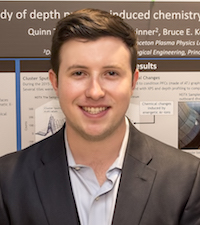
Quinn T. Pratt
University of San Diego
XPS study of depth profiling induced chemistry in NSTX-U tile samples
Quinn T. Pratt, Charles H. Skinner, Bruce E. Koel, Zhu Chen
The composition and conditioning of plasma facing components (PFCs) has been shown to strongly affect plasma performance. We report X-ray Photoelectron Spectroscopy (XPS) measurements of the elemental and chemical-state of a sample from a NSTX-U divertor tile. XPS depth-profiles of the top 200 nm were performed by sputtering the sample with a beam of monatomic argon ions and argon gas clusters. To assess the extent to which the etching beam modified the chemical-state of the surface, XPS depth profiles were also performed on samples of tantalum pentoxide, a sputtering standard, and a PEDOT:PSS polymer film that was used to mimic the response of amorphous carbon-hydrogen co-deposits. Measurements of the polymer film thickness also enabled a sputtering-time to depth calibration. Cluster sputtering was found to avoid the majority of chemical changed induced by argon ion sputtering in the NSTX-U sample. Argon ion sputtering also induced chemical changes in the polymer film and tantalum pentoxide but these changes were greatly reduced with cluster sputtering.
Poster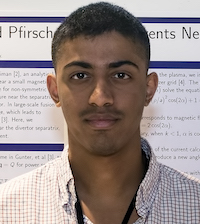
Dhanush Radhakrishnan
NYU
Heat Diffusion and Pfirsch-Schluter Currents Near a Tokamak Divertor Separatrix
Dhanush Radhakrishnan, Allan Reiman
In Reiman, Radhakrishnan, and previously in Reiman, an analytical calculation of the Pfirsch-Schluter current in and near a small magnetic island showed a logarithmic singularity at the X-line for non-symmetric geometries, which arises due to non-constant pressure near the separatrix. This project extends this work to a tokamak divertor. In large-scale fusion experiments, the ratio xi_||/xi_perp can become very large, which leads to numerical errors corrupting perpendicular transport. Here, a numerical solution of heat diffusion near the divertor separatrix is provided and the corresponding pressure-driven current, which is singular near the X-point, is calculated.
Poster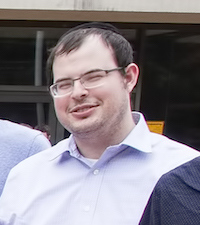
Nathaniel Sokolow
Community College of Baltimore County
Development of Web Tools for LTX-beta
Nathaniel Sokolow, Robert Kaita
LTX-Beta is a Tokamak designed to study the effects of surrounding plasmas with entirely low recycling walls, made of liquid lithium. Like any Tokamak, LTX has diagnostics to study the plasma. The data from these devices is digitized, and resides in a database called MDSplus. Every plasma shot has its own tree, which can then be accessed using scripts or built-in tools. The purpose of this project was to create a web application to access and use MDSplus data for plotting etc.; this required creating both a frontend and backend system – the frontend consisting of HTML code with which the browser would get the user input, and a backend, which would use the user’s parameters to process and output the desired data. A lightweight Python web framework, Flask, was used to build a plotting utility usable from inside of the PPPL firewall, and the servers were configured to run it.
Poster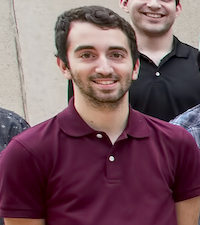
Josh Swerdlow
Yale University
Whistler Wave Generation due to Electron Temperature Anisotropy in Asymmetric Magnetic Reconnection and B-Dot Probe Construction for FLARE
Josh Swerdlow, Jongsoo Yoo, Masaaki Yamada, Hantao Ji
Whistler waves are a type of right hand polarized electromagnetic waves in the range of f_electron cyclotron ≤ f ≤ f_lower hybrid. The generation of whistler waves during asymmetric reconnection is studied by analyzing data from a MMS (Magnetospheric Multiscale) event. In particular, the possible role of electron temperature anisotropy in excitation of whistler waves on the magnetosphere side is discussed. Le Contel et al. proposed the perpendicular component of the electorn anisotropy drives the whistler mode during this asymmetric reconenction event. However, the parallel component of electron anisitropy can be the driver as well. To decide which drives the whistler mode in this event, the local electron distribution function is fitted into a sum of Maxwellian distribution functions. Then, the dispersion relation solver, WHAMP (waves in homogeneous, anisotropic, multicomponent plasmas), is used to obtain the local dispersion relation and growth rate of the whistler waves. We compare the theoretical calculations with the measured dispersion relation in order to find whether the perpendicular or parallel components of the electron anisotropy are driving the whistlers waves. In addition, a report on the construction and discussion of the B-Dot probes constructed for FLARE is provided.
Poster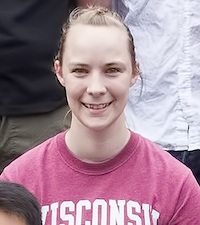
Megan Tabbutt
University of Wisconsin, Madison
Torque Measurements Using Strain Gauges on the Magnetorotational Instability Experiment
Megan Tabbutt, E. Gilson, K. Caspary, H. Ji
The Magnetorotational Experiment (MRI), at Princeton Plasma Physics Lab (PPPL), researches astrophysical phenomena. The MRI experiment is a cylindrical Couette geometry that uses Galinstan (GaInSn) as its working liquid. The inner and outer cylinders are free to rotate at separate speeds creating both stable and unstable conditions. The diagnostics currently in use on the experiment are Hall sensors and Ultrasound Doppler Velocimetry (UDV). The MRI is an instability thought to be responsible for turbulent angular momentum transport in accretion disks. Strain gauges have been shown to be a valid diagnos- tic technique for measuring torques in the system on Taylor-Couette devices previously (Lathrop, 1992). Strain gauges were constructed from thin brass bars and resistors, which were wired into a Wheatstone bridge configuration. The bars were calibrated using known torques to characterize the linear relationship between a voltage difference between adjacent sides of the bridge and the applied torque. The torque parameter regime that is expected to be reached by the MRI experiment given an ideal Taylor-Couette flow profile is milli-Newton-meters. The calibration tests were able to achieve results in this range that followed the same linear trend that was expected. The strain gauges were then preliminarily tested in a spinning liquid setting. Further research will include incorporating the strain gauges into the machine as a torque diagnostic.
Poster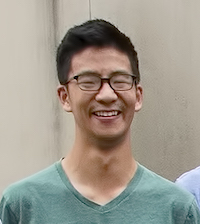
Yonry Zhu
Ohio University
Correlation of Carbon Arc Oscillations with Voltage and Current Measurements
Yonry Zhu, Vlad Vekselman
Nanostructure synthesis using a carbon arc discharge is promising but suffers from poor selectivity. Optimization of this method for nanotube growth requires understanding of the discharge physics. This work examines any relationships between current and voltage oscillations and movement of the carbon arc in the low and high ablation operational regimes. High-speed (30 kfps) video of the carbon arc is taken while discharge voltage and current are recorded with an oscilloscope. The arc core and surrounding bubble are imaged using two different camera filters. Current, voltage, and arc motion are weakly correlated in the low ablation regime and strongly correlated in the high ablation regime. A spike in input power is accompanied by movement of the arc while a drop in input power is accompanied by a lull in arc motion and an expansion of the surrounding bubble. The arc has negative differential resistance during the expansion of the bubble.
Poster